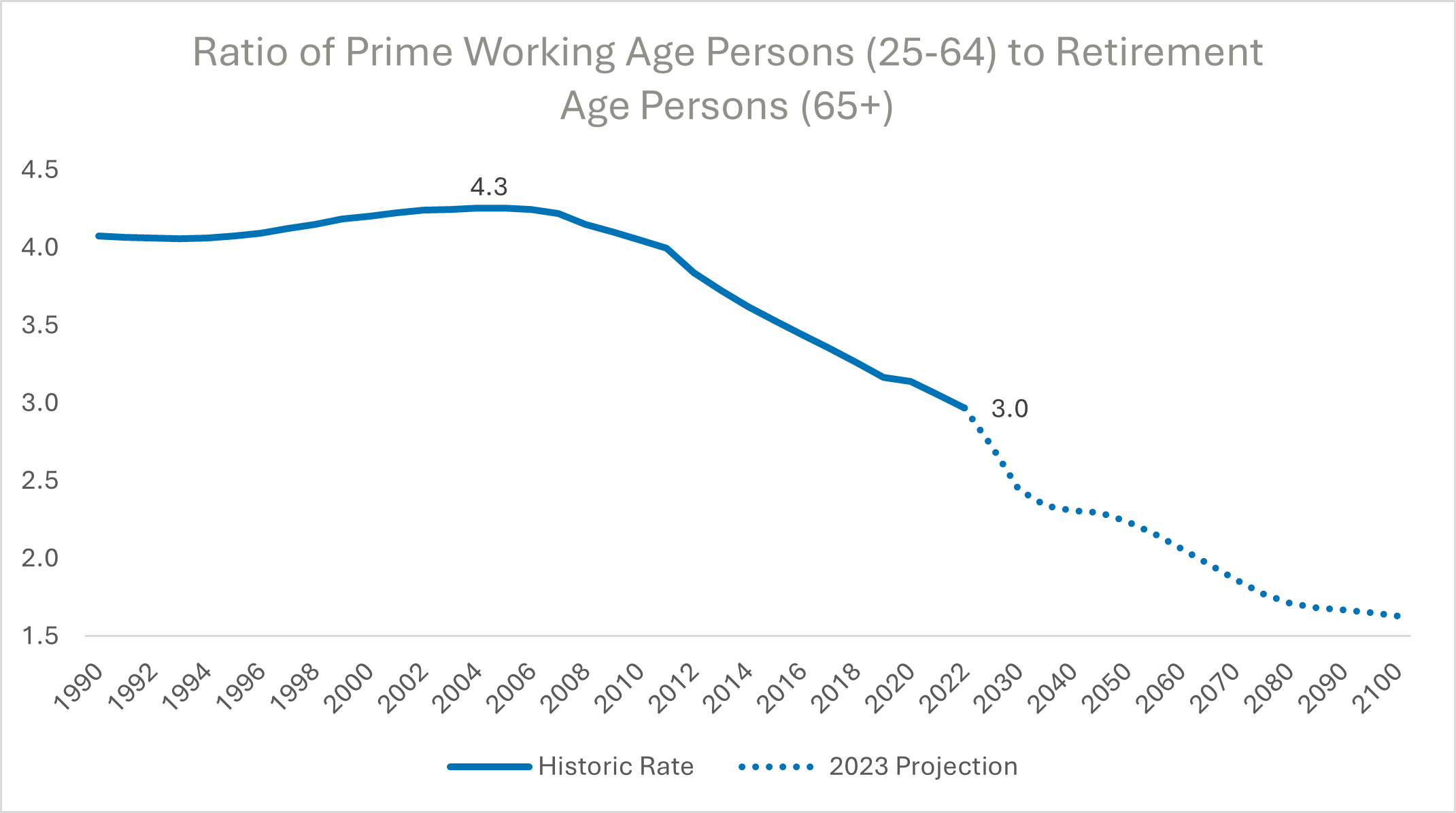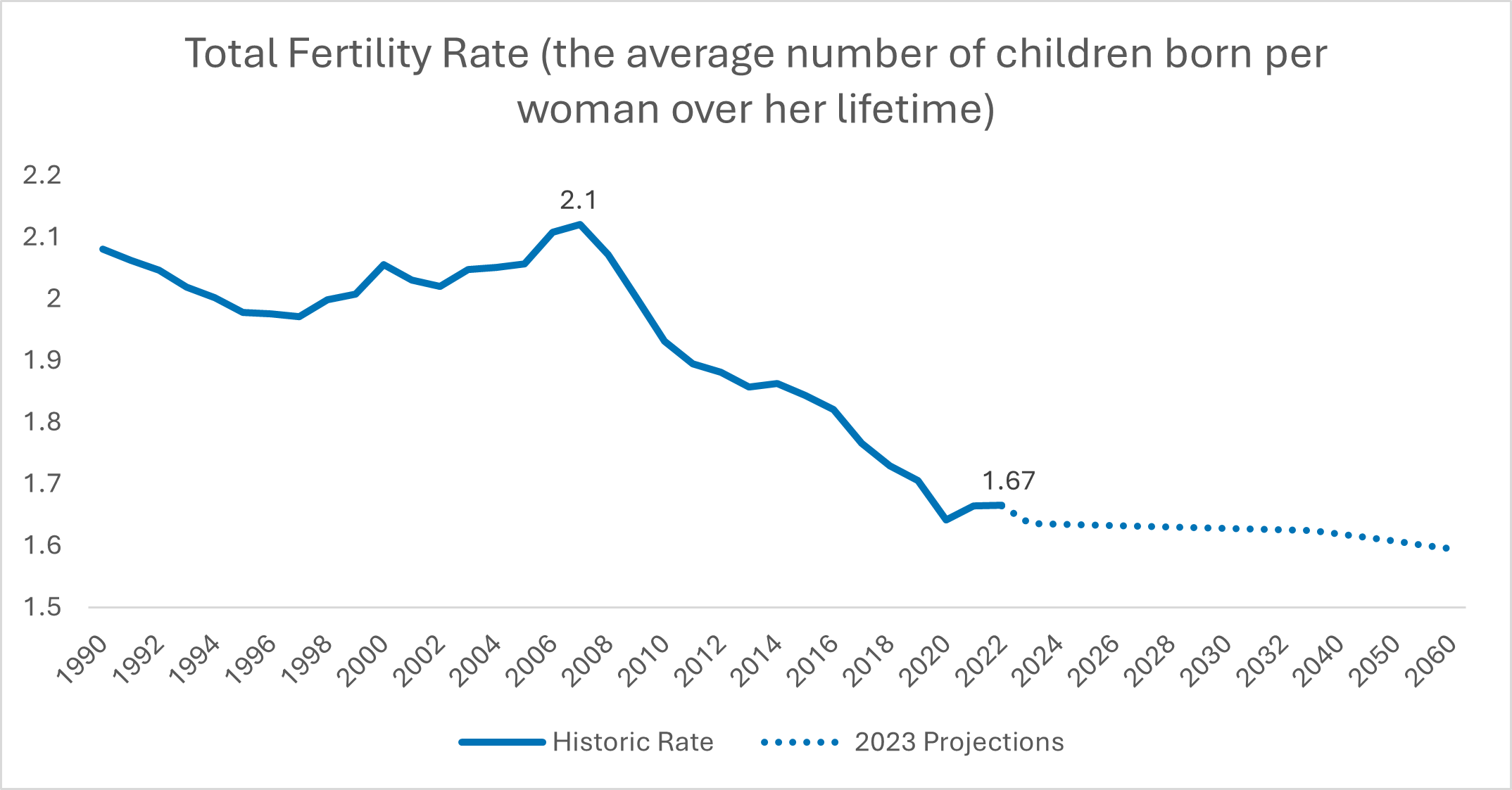Slower Population Growth Challenges US Economic Outlook
19 Dec. 2023 | Comments (0)
Recent projections from the U.S Census Bureau indicate a slowdown in US population growth that will dampen GDP growth going forward. The key driver behind this deceleration is a continuous decline in the fertility rate.
Trusted Insights for What’s Ahead™
- US population growth is expected to be slower than previously projected as the fertility rate continues to decline.
- The smaller contribution from labor due to slower population growth is expected to weigh on US real GDP growth going forward. The economy may grow by 1.7% on average over the next decade compared to 2.2% between 2011 and 2019.
- The slower population growth will also place a burden on tax revenues needed to support the growing elderly population.
- Solutions to a shrinking population and labor force include policies that keep women in the labor force, help older persons work longer, and increased immigration.
US population growth is expected to be slower than previously projected as fertility rate continues to decline
The U.S Census Bureau recently published population projections that show the population will peak in 2080 at 370 million and is expected to decline thereafter. The projected growth is significantly lower compared to the previous projection (published in 2017) which showed the total population would reach 405 million by 2060.
The slower population growth will place a burden on the available labor pool, hindering its ability to fuel economic growth and generate tax revenues needed to support the growing elderly population. The ratio of prime working age persons (age 25-64 – the ages when labor force participation peaks) to retirement age persons (age 65+ when labor force participation declines rapidly) is expected to decline rapidly from 3.0 right now to 2.4 in 2030 and to 1.6 by the end of the century (Chart 1).
Chart 1: Rate of prime working age to retirement age workers is expected to decline rapidly

The slower projected population growth is due to lower projected birth rates. The total fertility rate (the average number of children born per woman) declined rapidly from 2.1 in 2007 to 1.67 in 2022 (Chart 2). The US Census Bureau projects that the birth rate will fall to 1.6 by 2060, which is significantly below the replacement level fertility of 2.1, at which the total population remains constant from one generation to another without migration. For comparison, the Census Bureau’s previous projection in 2017 assumed that the long-term fertility rate would stabilize at 1.84 (its average between 2010-2017), but it kept dropping. The difference between the two projections cumulatively adds up to 28 million fewer births by 2060.
Chart 2: US Fertility rate is expected to continue declining

More women are opting not to have children and recent cohorts of women are having fewer births. The observed decline in fertility is influenced by a multitude of factors. Unintended and teen pregnancies declined sharply in the last 15 years. Furthermore, economic considerations including escalating costs of childcare and housing, expanding opportunities for women in the workplace, more female heads of households, shifting priorities including preferences for having fewer children, and availability of support systems, all contribute to the choices women make regarding family planning.
Due to low birth rates in past decades, US economic growth potential is expected to slow over the coming decades reflecting lower population growth. The contribution of labor inputs (quantity and quality of labor) to US GDP growth is expected to shrink from an average of 1.2% over the 2011-2019 period to only 0.3% on average over 2025-2036 period. This is because the share of working age population will continue to shrink.
The declining population growth raises serious concerns about the future funding of Social Security. With fewer contributors to the system, sustaining benefits for the growing elderly population becomes a significant challenge. A comprehensive review and potential reform of Social Security funding mechanisms are essential to ensure the long-term stability of this crucial social safety net.
A multifaceted approach to expanding the labor force is crucial to increasing US long term growth potential. Providing robust support systems for parents, such as affordable childcare, public provision of early childhood education and extended parental leave can help workers remain in the labor force. Encouraging individuals to work later in life through flexible arrangements and age-inclusive hiring practices taps into the valuable experience of older professionals. Reforming social security and Medicare to eliminate disincentives for working longer is crucial, ensuring that individuals are not penalized for contributing to the workforce beyond traditional retirement ages. Additionally, reforming legal immigration at all skill levels to address labor shortages is key to bolstering economic growth in the coming decades.
-
About the Author:Selcuk Eren
The following is a bio of a former employee/consultant Selcuk Eren, PhD, is a Senior Economist at The Conference Board. He is an experienced researcher in labor economics with a focus on demographics…


0 Comment Comment Policy